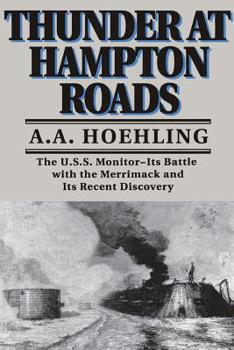Thunder at Hampton Roads: The U.S.S. Monitor--Its Battle with the Merrimack and Its Recent Discovery
Select Format
Select Condition 
Book Overview
On March 9, 1862, the "battle of the century" took place at Hampton Roads. The U.S.S. Monitor, the world's first all-iron fighting ship, repulsed the Confederate ironclad Merrimack. In so doing, the Yankee vessel demolished forever the "wooden walls" of the fleet's oak and billowing canvas and helped ensure a Northern victory in the Civil War. Thunder at Hampton Roads is the only book that covers the entire story of the Monitor, from its inception to its rediscovery in 1973. Drawing on personal accounts and old logs, Hoehling describes the life and times of the famous ship. Ridiculed as a freak of its day, the Monitor was specifically designed to combat the indestructible Merrimack. But is was such an odd-looking craft that one Union officer told the Swedish inventor, John Ericsson, to take his model home "and worship it, as it would not be idolatry, because it was in the image of nothing in the heavens above, or on the earth beneath, or in the waters under the earth."
Hoehling brings to life the exciting race between North and South to achieve naval supremacy. He vividly re-creates the Monitor's famous clash with the Merrimack and gives a dramatic account of how a team of marine scientists rediscovered the Monitor twelve miles off Cape Hatteras, resting on the ocean floor. Thunder at Hampton Roads is the complete story of one of the world's greatest fighting ships.
Hoehling brings to life the exciting race between North and South to achieve naval supremacy. He vividly re-creates the Monitor's famous clash with the Merrimack and gives a dramatic account of how a team of marine scientists rediscovered the Monitor twelve miles off Cape Hatteras, resting on the ocean floor. Thunder at Hampton Roads is the complete story of one of the world's greatest fighting ships.
Format:Paperback
Language:English
ISBN:0306805235
ISBN13:9780306805233
Release Date:March 1993
Publisher:Grand Central Publishing
Length:270 Pages
Weight:0.90 lbs.
Dimensions:0.6" x 6.0" x 8.9"
Customer Reviews
2 ratings
Thunder at Hampton Roads
Published by Thriftbooks.com User , 23 years ago
A. A. Hoehling?s Thunder at Hampton Roads tells the story of the U.S.S. Monitor, the world?s first all-iron fighting ship. The book covers the entire story of this famous vessel, detailing the construction of the vessel, the battle between it and the C.S.S. Merrimack, and its rediscovery in the mid-1970?s. The Monitor changed the image of the navy forever, ridding people of their notion of ships built of oak and canvas and replacing it with pictures closer to those invoked by the navy of today: ones of invincible metal and guns. The book begins with an account of the construction of the Monitor. Northern and Southern forces were racing for naval supremacy throughout the war, and ironclads were among the most important technology being developed. The Monitor was specifically designed to combat the seemingly indestructible Southern Merrimack. A Swede named John Ericcson conceived of the idea for the North. Though similar in design to the other ship, which had already been proven in battle, the Monitor's development was viewed with some skepticism; many people thought it would never float, much less act as a battle-ready warship. They were proved wrong, as the Monitor was proved as worthy as its Confederate opponent.The second section of the book details the Monitor?s encounter with the Southern ironclad Merrimack, and its sinkage off the coast of Cape Hatteras. The battle came in defense of a seaport called Hampton Roads. Both ships took substantial damage. The Monitor came away victorious, though the Merrimack did escape. Many people believed that the ironclad was the only thing that came between Hampton Roads and a complete ransacking by the Confederate Navy. The loss of the Monitor was an unfortunate incident. The ironclad was being towed by another ship, the Rhode Island, to Wilmington North Carolina, where it was indeed to take part in capturing the city. When the crew discovered that their ship was failing, they cut loose from the Rhode island so as to avoid bringing the other ship down with the Monitor. Luckily, most of the crew was able to escape via lifeboat. Sadly, fifteen crewmen, including the captain, went down with her. The third section of the book details the post-war lives of those who were involved with the Monitor, and tells of its rediscovery in the 1970?s. Many of the Monitor?s crewmen lived peacefully after the sinking, but one could not. Samuel Dana Greene, an executive officer on the Monitor whom many thought should have chased the Southern Merrimack until he had captured or destroyed it, killed himself. Supposedly he was consumed with guilt that was fed by the accusations over the fact that the Merrimack escaped to do further damage in the war. Only after his death was the matter cleared up by a superior officer who announced that the Monitor had sustained too much damage for it to follow the enemy ship. The Monitor was discovered and photographed by a team of marine scientists twelve miles off Cape
Strong thumbs up from ironclad officianado
Published by Thriftbooks.com User , 27 years ago
Still the best book on the history of the USS Monitor. Hoeling is both an excellent researcher and a first-rate writer. I am very pleased this book is back in print. Naval historians should rejoice!





